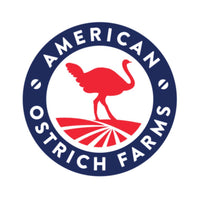When people find out you work on an ostrich farm, their initial disbelief is quickly replaced by an enthusiastic curiosity. It’s no surprise why; the world’s largest living bird is a strange and wonderful animal, and one that few have seen up close. Here are answers to the questions people ask us most often.
WHERE ARE OSTRICHES FROM?
The ostrich is native to the African continent, where wild populations live in the dry, hot savannas and woodlands. Ostriches can tolerate a wide range of temperatures and conditions, however, which is one of the reasons ostrich farms can be found around the globe, including North America, Australia, Europe, and in the Middle East.
The ostrich’s closest living relatives are the emu, cassowary, rhea, and kiwi, each of which is classified as a ratite, members of a group of flightless birds. The emu and cassowary are native to Australia, while the rhea hails from South American, and the kiwi is found in New Zealand.
HOW BIG DOES AN OSTRICH GET?
Size is a matter of several factors, including sex, age, and genetics. Males grow to be between 7 and 9 feet tall and can weigh up to 350 pounds. Females range from 6 to 8 feet tall and weigh as much as 300 pounds. Ostriches are the largest living bird, and the fastest animal on two legs. A fully-grown ostrich can sprint up to 43 MPH and can cover 10 to 15 feet in a single stride!
CAN YOU RIDE AN OSTRICH?
For the comfort and safety of our ostriches, we do not allow anyone to ride them here at American Ostrich Farms. Ostrich racing, however, is a sport practiced in parts of Africa, as well as in a handful of locations across North America. In these races, a jockey commonly rides atop the ostrich as one would a horse, although occasionally the jockey rides behind the bird in a wagon or chariot. The practice has a long history; in fact, archeologists recovered a statue of the ancient queen Arsinoe II (316-270 B.C.) riding an ostrich from a tomb in Egypt.
WHAT DO OSTRICHES EAT?
Ostriches are omnivores, meaning that their diet comprises both plant and animal food sources. While ostriches eat more plant matter, they will also opportunistically consume insects, other invertebrates, and small reptiles.
DO OSTRICHES REALLY BURY THEIR HEADS IN THE SAND?
Despite what you may have seen in cartoons, ostriches don’t hide their heads in the sand. This misconception may originate from their defensive behaviour of lying low and pressing their long necks to the ground in an attempt to become less visible. Their feathers blend well with sandy soil, giving the appearance that they’ve buried their heads under the sand when viewed from a distance.
Ostriches do, however, display other amusing behaviors. When they are content, ostriches will often spin in tight circles as they are depicted doing in the ballet scene in the animated Disney film, Fantasia.
HOW MANY EGGS DOES AN OSTRICH LAY EACH YEAR?
In the wild, a female ostrich typically lays 12–18 eggs during the breeding season. Under farm conditions, however, young females produce 20 eggs in their first breeding year and up to 100 eggs annually (most commonly 20–40 eggs) in subsequent years.
CAN YOU EAT OSTRICH EGGS?
Yes, ostrich eggs are edible and taste similar to chicken eggs, with a flavor that has been described as richer and somewhat more buttery. Ostrich eggs are very nutritious, providing a good source of protein, vitamins A and E, as well as zinc, manganese, and selenium. Each egg weighs approximately 3-5 pounds and is roughly equivalent to two dozen chicken eggs! Ostrich eggs are not a common food source in the Americas, as the retail cost of an edible ostrich egg can be upwards of $100.
IS OSTRICH A WHITE MEAT LIKE CHICKEN, OR A DARKER MEAT LIKE DUCK?
Neither! While the USDA classifies ostrich meat as poultry, it is very much a red meat. Ostrich looks like, tastes like, and cooks like a high-quality cut of lean beef or bison. Like beef, ostrich meat gets its color from myoglobin, a protein that turns red in the presence of oxygen.
Ostrich is naturally lean (less than 5% fat, although by taste you wouldn’t realize it), higher in iron, and lower in both calories and cholesterol than other red meats. All interior muscle cuts on an ostrich are similar to the most lean, tender cuts on a beef or bison, making it a delicious and healthful alternative.
ARE OSTRICHES MEAN?
Like many animals, ostriches have unique personalities and character traits. Some are quite inquisitive, while others are timid, or playful, or yes, aggressive. With their large size, powerful legs, and sharp talons, it’s always a good idea to exercise caution when encountering an ostrich. That said, an unprovoked ostrich is unlikely to attack, only doing so when it feels directly threatened.






